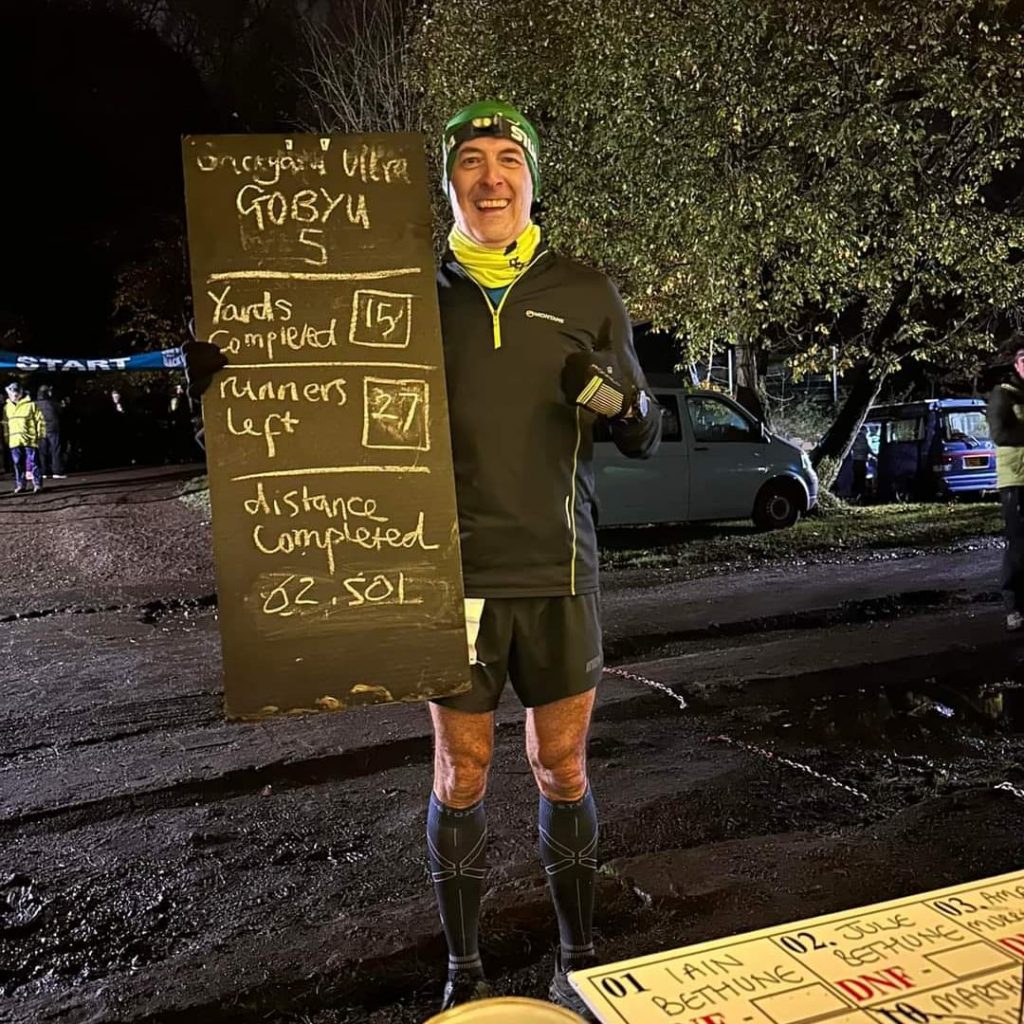Recently entered your first Backyard Ultra (BYU) and wondered what you’ve got yourself into? Or heard lots of talk about this strange event and wondered whether to get in on the action? In this series of guides, I’ll unpack some of the main things you need to know to help you prepare for your first BYU, or to persuade you to take the plunge. So to kick us off, here’s a brief overview of the event format – highlighting some of the key things you need to know about how the race works and what to expect on the day.
A Bit of Background – Just One More Loop…
I’m not going to give you a history lesson on the origins and development of the BYU format. There’s loads of information online if you want to know more – have a look at https://backyardultra.com/ for all the facts and figures about backyard ultras. But in a nutshell, the format is the brainchild of Garry Cantrell aka ‘Laz’, also the brains behind the infamous Barkley Marathons. The races consists of a 4.2mile loop starting on the hour every hour until the runner can’t or won’t continue. The distance is calculated so that if you last 24 hours you will have completed 100 miles. The last person standing is the winner, all others are classed as DNF. Laz started BYUs literally in his own backyard and the format has spread like wildfire across the globe, with the current record holder Harvey Lewis completing an eye-watering 108 yards (450 miles) in 2023. Everyone competes together – there are no categories of winners based on gender or age.
The Race Set Up
Background complete, here’s what you can expect when you arrive at your first BYU.
Communal Area
Every BYU will have a communal area of some sort, but this will vary from event to event. As a minimum, there will usually be toilets, a medical point and hot and cold water. Most BYUs will go a bit further than this and have some basic snacks, a rest area, and provision for basic food preparation such as a fridge and microwave. There isn’t usually room for many competitors to sit down in the communal area, but if you don’t have a crew then some BYUs will give you priority space in this area to set out your supplies so that it is easy for you to do whatever you need to between laps. Tips Don’t rely on the race snacks even if they are provided. You can’t guarantee that there’ll be enough of what you want for the duration of the race, and you will need something more substantial at some point if you are in it for the long haul; Bring your own supply of toilet roll and hand sanitiser – toilet faclities are often quite basic and don’t always stand up brilliantly to the test of 24 hours plus of ultra runners’ stomachs!
Your Pitch
Most BYUs are set up in quite generous spaces where there is room to camp or set up support points. Most encourage runners to bring a support crew – which may be several family members, and some will allow dogs on leads too. Some only allow tents but many will accommodate camper vans by arrangement. You can arrive the night before or early on the day of the race, pitch your tent and camp overnight if you want to. There’s also usually room for you to have a gazebo – or camp in a big tent – so that you have room to set up all the stuff you will need during the race as well as to sleep.
Don’t be frightened to bring LOTS of stuff, provided there’s a purpose to it all and you can keep it organised. People really do set up their own mini-villages, and if you’re planning on being there for a while you need to ensure that you are your crew can stay comfortable, not to mention fed, watered, appropriately clothed and eventually stuck together with ducktape. Here’s a few keys things that you’ll need – more details about kit and organisation in a later post:
Tent/ shelter and overnight bed etc if camping; Comfy chair – preferably one which reclines – and a warm blanket/ similar for inter-lap micro rests;
Food, hydration and utensils for you and your crew – include some proper meals and bring more than you think you can possibly get through;
Changes of clothes and shoes to account for weather changes and allow you to feel clean and give your feet a change of cushioning every now and again;

First aid and footcare kit and hygiene/ sanitary products; Headtorches for you and your crew, chargers and spare batteries – most BYUs don’t have any central charging points;
Ways to organise the above, especially if you are un-crewed.
The Corral
This is hub of it all – the point where every lap will start and finish. The corral is a specifically delineated area which is designed to hold the number of runners who will start the race. It is essential to understand the importance of the corral:
If you’re not in the corral when the bell goes at the beginning of each hour, you are out of the race, even if you’re stood a couple of yards away doing your shoe laces up;
Once you are in the corral, you can’t get any support – even if it’s just your crew handing over a new water bottle, you have to step out of it to do this;

Only runners are allowed in the corral for the beginning of each loop;
When you come back at the end of the loop, you will run into the corral and your completion will be recorded – the way this is done varies from race to race so make sure you know what you need to do to ensure your loop counts.
The Race
As I’ve already said, each loop is 4.2 miles long and starts on the hour, every hour. At 3 minutes to the hour, a 3 minute warning will sound. There’ll then be follow-up warnings at 2 and 1 minutes, and then the bell to start the Lap:
If you’re not in the corral when this final bell goes, that’s your race over;
Once the lap has started, you can’t get help or return to your camp until the loop is complete;
You must complete the loop in time to be back in the corral for the start of the next loop;
Within these constraints, you can pace yourself as you please and you will notice some people finishing in under 35 minutes with others coming in just before the bell, even in the early laps (more on pacing in another installment!);
Whilst on the loop you can eat, drink, change clothes, whatever you like – so long as you’ve brought these things with you. You can’t use running poles or other similar assistance;
BYUs are a really socialable race format as there is little pressure on pace and everyone regroups at the start of each lap. Plus there is a joint investment in seeing how far the winner can get, which of course requires at least one other person to stay in the race too. Retired runners and their crew often hang around after they’ve finished to watch the action play out;
Your race can end because you are timed out, or because you return to camp with a loop unfinished, or because you refuse to get out of your chair to start the next loop;
Once there are only 2 runners left, the next runner to drop will be called the ‘assist’. The final runner must complete 1 more loop to be crowned the winner. If they don’t then everyone will be a DNF.
The End
When it’s all over for you, you might get to ring the bell or get your DNF picture taken – each event will vary. You’ll also get some kind of race memento, again these vary enormously but you won’t generally get the traditional medal or T-shirt.
And as I’ve said, once you’re finished, get some rest and then hang around to support the other runners as they continue the challenge – assuming you’re not the winner of course!
Hope you have a fantastic experience of your first BYU. Keep a look out for the next installment and let me know if you have any questions that you’d like answering.

